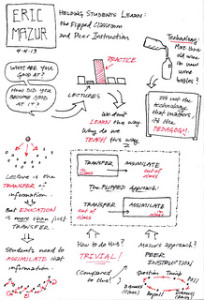Visual association and recollection in the classroom with Sketchnotes
 Recently, Alan Russell, professor of mathematics and assistant director for the Center of Advanced Teaching and Learning, held a seminar called “Deliberate Doodling,” focusing on creating visuals for teaching important concepts. Russell uses the Sketchnotes method as a foundation to challenge attendees to think about the use of visual associations in the classroom.
Recently, Alan Russell, professor of mathematics and assistant director for the Center of Advanced Teaching and Learning, held a seminar called “Deliberate Doodling,” focusing on creating visuals for teaching important concepts. Russell uses the Sketchnotes method as a foundation to challenge attendees to think about the use of visual associations in the classroom.
How Sketchnotes works
In his 2013 book about the concept, Mike Rohde introduced Sketchnotes as a note-taking technique with a more visual approach. Note-takers draw pictures and use brief words and phrases to illustrate prominent points throughout the lecture. Sketchnotes challenges people to use only five simple drawing elements (line, dot, square, circle and triangle), so someone doesn’t have to be particularly artistic to use this method successfully.
Sketchnotes utilizes illustrations to act as landmarks the note-taker can see and associate with certain points later. By utilizing more visually stimulating components with written notes, people have something more than words to associate with the information, so notes will carry more weight and meaning than simply scribbling down concepts word for word.
Sketchnotes in teaching
Russell decided to take the Sketchnotes concept a step farther. In his classes, he has used the Sketchnotes method as a way to illustrate concepts, in hopes of creating images that reflect the concepts’ meaning.
Russell tried this in his statistics class, where he and his students would create an illustration for a topic, in which the sketch would act as a reminder and would visually reinforce the concept. Russell said this was so helpful that students would draw the representations on their tests to help them recall the information.
During the workshop, one professor suggested that the illustrated metaphor could be a device an entire department could create and utilize. For example, in the philosophy department, beginner students learn concepts that their professors build upon in the more advanced courses. If the professors had a central metaphor for some of these concepts, it would keep the imagery consistent among the different sections of a course, and provide a basic sketch professors could add to as the concept becomes more complex.
However, associating a visual with a concept won’t always work out as planned. An attendee pointed out that an illustrated metaphor can reflect a concept’s meaning but also expose inconsistencies between the metaphor and the concept.
The Sketchnotes method for teaching concepts may not be completely solid yet, but the attendees realized the potential a visual aid has to improve the understanding of a concept in the classroom.
Do you think a strategy like Sketchnotes is an effective way to teach concepts in your discipline? Let us know what you think in the comments below.
Top image from Flikr user derekbruff / CC BY-NC 2.0
 Follow
Follow

